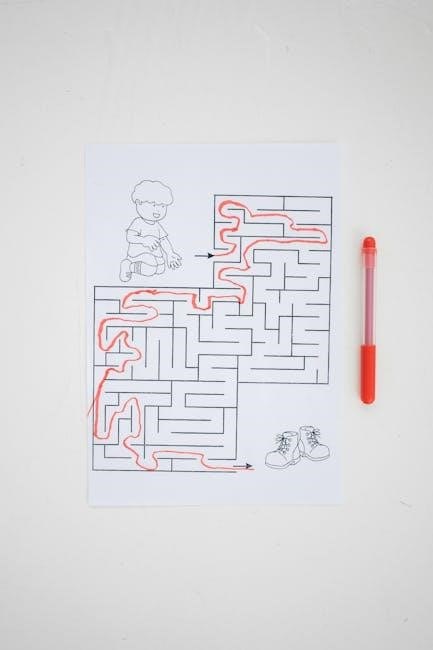Mastering inequalities is a foundational math skill, essential for problem-solving and real-world applications. This guide provides step-by-step solutions and graphing techniques, supported by an answer key for self-assessment and improved learning outcomes.
Understanding the Importance of Inequalities in Math
Inequalities are a cornerstone of mathematics, enabling the comparison of quantities and the modeling of real-world scenarios. They are essential for problem-solving, as they allow for the representation of ranges and boundaries in various contexts, such as resource allocation, scientific measurements, and optimization. Mastering inequalities enhances critical thinking and analytical skills, which are vital in STEM fields and everyday decision-making. The ability to solve and graph inequalities is particularly valuable, as it provides visual and numerical insights into relationships between variables. By practicing with worksheets and using answer keys for self-assessment, students can build confidence and proficiency in this fundamental area of mathematics.
Brief Overview of Graphing Inequalities
Graphing inequalities involves visualizing the solution set of an inequality on a number line or coordinate plane. For linear inequalities, this typically means shading the region that satisfies the inequality, either above or below a line. The process begins by solving the inequality algebraically, then plotting the boundary point, and finally shading the appropriate region. For compound inequalities, multiple regions may need to be considered. Using test points ensures accuracy in determining which side of the boundary to shade. Interactive tools and worksheets can simplify the learning process, while answer keys provide a reference to check solutions. Regular practice helps build proficiency in interpreting and graphing inequalities effectively.
Why Answer Keys are Essential for Learning
Answer keys are indispensable tools for self-assessment and understanding complex concepts like solving and graphing inequalities. They provide clear, step-by-step solutions, enabling students to verify their work and identify mistakes. By comparing their solutions to the answer key, learners can pinpoint errors and grasp the correct methods. This fosters independent learning and builds confidence. Additionally, answer keys offer a reference for teachers to create structured lessons and assignments. Regular use of answer keys enhances problem-solving skills and ensures mastery of inequality concepts, making them a vital resource for both students and educators seeking to improve math proficiency.

Understanding Inequalities
Inequalities compare values using symbols like <, >, ≤, or ≥. They are crucial for solving real-world problems and understanding relationships between quantities. The answer key PDF provides clear solutions to practice problems, helping learners master inequality concepts and improve their math skills through self-assessment and step-by-step guidance.
What Are Inequalities?
Inequalities are mathematical statements that compare two or more values using symbols such as < (less than), > (greater than), ≤ (less than or equal to), ≥ (greater than or equal to), and ≠ (not equal to). They are essential for expressing relationships between quantities and are widely used in various fields, including science, engineering, and economics. Unlike equations, inequalities do not have a single solution but rather a range of values that satisfy the condition. For example, the inequality 2x > 4 has solutions where x is greater than 2. The answer key PDF for solving and graphing inequalities worksheets provides clear solutions and explanations, helping learners understand how to interpret and solve these mathematical expressions effectively.
Types of Inequalities: Linear, Quadratic, and More
Inequalities can be categorized into different types based on their complexity and the degree of the variable. Linear inequalities involve variables raised to the first power and are the simplest to solve. Quadratic inequalities include squared variables, often requiring factoring or graphing to find solutions. Polynomial inequalities extend this concept to higher-degree polynomials, while rational inequalities involve fractions with variables in the denominator. Absolute value inequalities add another layer by incorporating absolute value expressions. Each type requires specific strategies for solving and graphing, as demonstrated in the answer key PDF. Understanding these variations is crucial for mastering inequality problems and applying them to real-world scenarios effectively.
Inequality Symbols and Their Meanings
Inequalities use specific symbols to represent relationships between values. The less-than sign (<) indicates that one value is smaller than another, while the greater-than sign (>) shows one value is larger. The less-than or equal-to symbol (≤) and the greater-than or equal-to symbol (≥) include the possibility of equality. The not-equal-to symbol (≠) signifies that two values are not the same. These symbols form the basis of inequality expressions and are essential for solving and graphing problems. Understanding their meanings is crucial for interpreting and working with inequalities effectively. The answer key PDF provides clear examples of how these symbols are applied in various inequality types, helping learners grasp their usage and significance in mathematical problem-solving.

Solving Inequalities
Solving inequalities involves reversing operations and considering inequality direction. The answer key PDF guides through examples, ensuring understanding of each step and strategy.
Basic Steps to Solve Inequalities
To solve inequalities, start by simplifying both sides and isolating the variable. Reverse operations step-by-step, ensuring the inequality direction remains correct unless multiplying or dividing by a negative number. Always check if the inequality sign needs to be flipped. After isolating the variable, verify the solution by substituting it back into the original inequality. For compound inequalities, split the problem into two separate inequalities if necessary. Use the answer key to confirm your solutions and understand common mistakes. Graphing the solution on a number line helps visualize the range of values. Practice regularly to master these steps and improve problem-solving skills effectively.
Solving Inequalities with Reverse Operations
Solving inequalities involves using reverse operations to isolate the variable. Start by simplifying both sides, then apply the inverse operation to undo addition, subtraction, multiplication, or division. For example, if you have ( x + 3 > 5 ), subtract 3 from both sides to get ( x > 2 ). When multiplying or dividing by a negative number, remember to reverse the inequality sign. Always check if the operation affects the inequality direction. Using the answer key, verify your solutions and identify common errors. Practice these steps to build confidence in solving inequalities effectively. Regular review and application of reverse operations will enhance your problem-solving skills and understanding of inequality concepts.
Special Cases: Compound and Absolute Value Inequalities

Compound inequalities involve two or more conditions connected by “and” or “or.” For example, 2 < x < 5 requires x to satisfy both inequalities simultaneously. Absolute value inequalities, such as |x| > 3, represent distances on the number line, leading to two cases: x > 3 or x < -3. When solving these, break them into separate inequalities and graph the combined solution. Always check if the solution satisfies the original inequality. The answer key provides examples and solutions to common compound and absolute value problems, helping you identify patterns and avoid mistakes. Regular practice with these special cases will strengthen your ability to handle complex inequality scenarios effectively.
Graphing Inequalities
Graphing inequalities involves identifying the inequality type, testing points, and shading the correct region. Use number lines or coordinate planes to visualize solutions effectively for clear understanding.
Steps to Graph Linear Inequalities
To graph linear inequalities, start by identifying the inequality type and rewriting it in slope-intercept form if necessary. Next, graph the corresponding linear equation by plotting the y-intercept and using the slope to find additional points. Draw a dashed line if the inequality is strict (e.g., < or >) or a solid line if it is inclusive (≤ or ≥). Determine the direction to shade by testing a point not on the line. If the test point satisfies the inequality, shade that side of the line. For compound inequalities, repeat the process for each part. Use number lines for simple inequalities or coordinate planes for more complex ones. Always verify your graph with the answer key to ensure accuracy and understanding.
How to Shade the Correct Region
To shade the correct region for an inequality, first determine the direction of the inequality (≤, ≥, <, or >). Graph the corresponding line as a boundary. If the inequality is ≤ or ≥, the line is solid; for < or >, it is dashed. Choose a test point not on the line and substitute it into the inequality. If the test point satisfies the inequality, shade the region containing the point. For compound inequalities, repeat the process for each part. Ensure the shading aligns with the inequality’s direction. Always refer to the answer key to confirm your shading is accurate. This step ensures clarity and precision in visualizing the solution set.
Using Number Lines for Simple Inequalities
Number lines are a powerful tool for visualizing simple inequalities. They provide a clear representation of the relationship between numbers. To use a number line, first identify the direction of the inequality (e.g., ≤ or ≥). Mark the boundary point corresponding to the inequality’s value. If the inequality is strict (e.g., < or >), leave the circle open; if it includes equality (≤ or ≥), close the circle. Shade the region in the direction indicated by the inequality. For compound inequalities, repeat the process for each part. Number lines are especially helpful for identifying intervals and understanding the concept of “between” in inequalities. They also make it easier to spot errors in shading or direction. Always cross-check with the answer key to ensure accuracy.
Interactive Tools for Graphing Inequalities
Interactive tools like QuickMath and Kuta Software offer dynamic ways to graph inequalities. These tools allow users to input inequalities and instantly see the graph, enhancing understanding. Features include real-time adjustments, zoom capabilities, and color-coded shading for clarity. They are ideal for visual learners, providing immediate feedback and simplifying complex concepts. Many tools also include step-by-step solutions, aligning with the answer key for self-assessment. These resources are accessible online, making them convenient for practice. By leveraging technology, students can explore inequalities interactively, improving retention and problem-solving skills. These tools are particularly useful for homework and study sessions, offering a hands-on approach to learning. They cater to diverse learning styles, ensuring a comprehensive grasp of inequality graphing.

The Answer Key PDF

The answer key provides correct solutions and explanations for inequalities, enabling self-assessment and understanding of mistakes. It aligns with worksheets, ensuring accurate and comprehensive learning outcomes.

Importance of the Answer Key for Self-Assessment
The answer key is a vital tool for self-assessment, allowing students to verify their solutions and understand their mistakes. It provides clear explanations and correct solutions, enabling learners to identify gaps in their understanding. By comparing their work with the answer key, students can track their progress and improve problem-solving skills. This resource fosters independence and confidence, as learners can assess their own performance without external help. Regular use of the answer key enhances retention and mastery of inequality concepts, ensuring a strong foundation for advanced math topics. It also helps teachers identify common errors and tailor instruction to student needs, making it an indispensable resource for effective learning.
How to Read and Interpret the Answer Key
To effectively use the answer key, start by reviewing the structured format, which typically includes numbered solutions corresponding to worksheet problems. Each answer is often color-coded or highlighted for clarity. Begin by comparing your solutions side by side with the key to identify mismatches. Pay attention to step-by-step explanations provided for complex problems, as they reveal common pitfalls and best practices. If an answer differs, retrace your steps to pinpoint errors. Use the key to understand the logic behind each solution, ensuring comprehension of concepts like inequality direction and graphing techniques. Regularly reviewing the answer key helps refine problem-solving strategies and builds confidence in tackling inequalities. This systematic approach ensures thorough understanding and improved accuracy in future problems.
Using the Answer Key to Improve Problem-Solving Skills
The answer key is a powerful tool for enhancing problem-solving abilities. Begin by identifying incorrect answers and analyzing the step-by-step solutions provided. This helps pinpoint common mistakes and gaps in understanding. Use the key to create a personalized study guide, focusing on areas where errors occurred. Regular practice with similar problems, referencing the key for accuracy, strengthens skills over time. Additionally, the key’s explanations offer insights into efficient methods for solving inequalities, reducing reliance on trial and error. By systematically reviewing and applying the key’s feedback, learners can develop a deeper grasp of inequality concepts and improve their overall problem-solving efficiency. Consistent use of the answer key fosters confidence and mastery in tackling complex inequalities.
Solving and Graphing Inequalities Worksheet
This worksheet offers comprehensive practice in solving and graphing inequalities, featuring various problem types and an answer key for self-assessment and skill improvement.
Features of a Good Worksheet

A good worksheet for solving and graphing inequalities should include clear instructions, varied problem types, and an answer key for self-assessment. It should also provide step-by-step solutions for complex problems, ensuring learners understand the process. Visual aids, such as graphs and number lines, can enhance understanding. Additionally, interactive elements, like fill-in-the-blank exercises and multiple-choice questions, keep students engaged. The worksheet should cater to different skill levels, offering both basic and advanced problems. Organized formatting and concise language help reduce confusion. Finally, the inclusion of real-world applications makes the practice relevant and meaningful, encouraging learners to see the practical value of mastering inequalities.

Tips for Completing the Worksheet Effectively
To complete the worksheet effectively, start by reviewing the answer key to understand expected solutions. Begin with simpler inequalities to build confidence. For each problem, carefully identify the inequality type and apply appropriate solving steps. When graphing, always shade the correct region and use number lines for clarity. Break down complex inequalities into smaller parts for easier management. Use the answer key to check your work and understand mistakes. Practice regularly to improve problem-solving skills. Highlight key terms and concepts to reinforce learning. By following these tips, you can master solving and graphing inequalities efficiently and effectively.
Common Mistakes to Avoid
When solving and graphing inequalities, common mistakes include reversing inequality signs incorrectly and misapplying operations. Forgetting to flip the sign when multiplying or dividing by a negative number is a frequent error. Additionally, students often shade the wrong region on graphs, especially for “less than” or “greater than” scenarios. Misinterpreting compound inequalities and absolute value inequalities can also lead to incorrect solutions. To avoid these errors, carefully review each step, double-check inequality direction, and ensure shading aligns with the inequality symbol. Using the answer key for self-assessment can help identify and correct these mistakes, improving overall problem-solving accuracy and graphing precision.

Additional Resources and Practice
Enhance your skills with online tools like QuickMath and Kuta Software. Utilize the answer key PDF for self-assessment and explore interactive learning apps for better understanding and improved problem-solving.
Recommended Websites for Inequality Practice
For effective practice, visit QuickMath and Kuta Software, which offer comprehensive tools for solving inequalities. QuickMath provides step-by-step solutions, while Kuta Software generates customizable worksheets. Additionally, Vocabulary.com enhances math vocabulary skills. These platforms, along with the answer key PDF, ensure a well-rounded learning experience. Utilize these resources to master inequality concepts and improve problem-solving abilities through interactive and structured practice. Regular use of these websites will build confidence and proficiency in graphing and solving inequalities, making them indispensable for students and educators alike.
Apps and Tools for Interactive Learning
Enhance your learning experience with interactive tools like Desmos Graphing Calculator and GeoGebra, which offer dynamic graphing capabilities for inequalities. Desmos allows real-time visualization of inequality solutions, while GeoGebra provides interactive simulations to explore inequality concepts. Additionally, Photomath offers step-by-step solutions for solving inequalities, making it an excellent resource for understanding complex problems. These tools, combined with the answer key PDF, create a comprehensive learning environment. They enable students to engage actively with the material, fostering deeper understanding and retention. By leveraging these apps, learners can practice, visualize, and master inequality solving and graphing skills more effectively.
Importance of Regular Practice
Regular practice is crucial for mastering the skills of solving and graphing inequalities. Consistent practice helps build problem-solving abilities, enhances understanding, and boosts confidence. By working through various problems, students can identify common mistakes and refine their techniques. Utilizing resources like video explanations, step-by-step solutions, and interactive tools can make practice more engaging and effective. Over time, regular practice leads to improved performance and a deeper grasp of inequality concepts. Incorporating the answer key PDF into your practice routine allows for self-assessment and targeted improvement. Dedication to regular practice ensures long-term success in math and prepares students for more advanced challenges in algebra and beyond.
